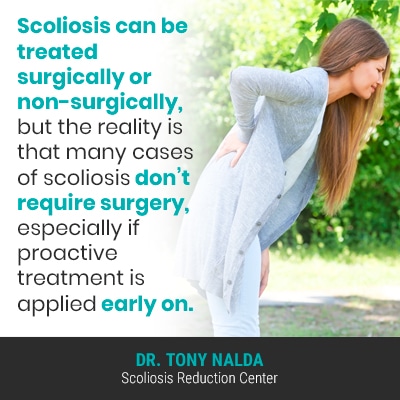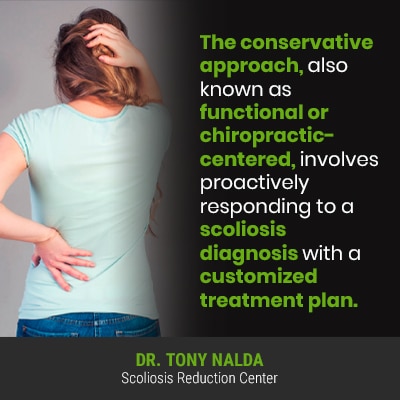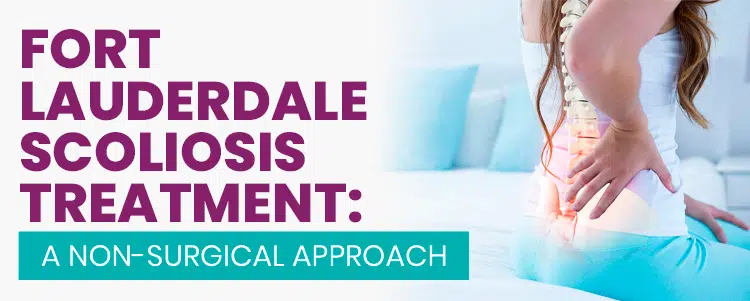Scoliosis can be a confusing condition to be diagnosed with and a complex condition to treat. There are two main scoliosis treatment approaches to choose between, and each offers patients a different potential outcome: traditional and conservative. I consider educating patients on the different treatment options available an important part of my role as a scoliosis-treatment provider.
For residents of Fort Lauderdale, Fl, there are only 212 miles and a 3.5-hour drive between them and world-class non-surgical scoliosis treatment. Celebration, Orlando is home to Dr. Tony Nalda, a scoliosis chiropractor renowned for the impressive results his treatment center achieves.
Let’s start our discussion of Fort Lauderdale scoliosis treatment by first exploring some general condition characteristics.
Looking for another city in Florida for scoliosis treatment?
- Daytona Beach Area Scoliosis Treatment
- Sarasota Area Scoliosis Treatment
- Tallahassee Scoliosis Treatment
- Tampa Scoliosis Treatment
- Orlando Scoliosis Treatment
- Miami Scoliosis Treatment
- Jacksonville Scoliosis Treatment
- Pensacola Area Scoliosis Treatment
What is Scoliosis?
Being diagnosed with scoliosis doesn’t have to mean living a life of limitations; in fact, it can mean quite the opposite.
There are numerous examples of well-known people who are not only living with the condition but thriving with it. As the Scoliosis Research Foundation puts current estimates at close to seven million people living with scoliosis in the United States alone, the spinal condition is more prevalent than many people realize.
Being diagnosed with scoliosis means an unnatural sideways spinal curve, with rotation, has developed, with a minimum Cobb angle of 10 degrees.
Cobb angle is known as the orthopedic gold standard in the diagnosis and assessment of scoliosis, and the measurement determines condition severity levels of mild, moderate, severe, or very severe:
- Mild scoliosis: Cobb angle measurement of between 10 and 25 degrees
- Moderate scoliosis: Cobb angle measurement of between 25 and 40 degrees
- Severe scoliosis: Cobb angle measurement of 40+ degrees
- Very-severe scoliosis: Cobb angle measurement of 80+ degrees
The wide range of Cobb angle measurements shows how highly-variable scoliosis is, meaning no two experiences of life with the condition will be the same, just as no two treatment plans should be the same.
It’s the complex nature of scoliosis that necessitates a customized treatment approach; the specifics of each patient and their condition type need to be addressed accordingly.
Another key condition characteristic is that scoliosis is progressive, meaning it’s in its nature to worsen over time, particularly if left untreated or not treated proactively.
Where scoliosis is at the time of diagnosis is not indicative of where it will stay; even scoliosis diagnosed as mild can easily progress to moderate, severe, or very severe, which is why deciding on a treatment approach/provider to commit to is such an important decision.

Scoliosis can be treated surgically or non-surgically, but the reality is that many cases of scoliosis don’t require surgery, especially if proactive treatment is applied early on.
For those in the Fort Lauderdale area, non-surgical treatment, with proven results, delivered by one of the world’s leading scoliosis chiropractors, is a mere 212 miles away in Celebration, Orlando at the Scoliosis Reduction Center®.
Let’s now take a look at the main differences between a traditional and conservative approach to scoliosis treatment.
The Traditional Surgical Approach to Scoliosis Treatment
When it comes to the traditional approach to scoliosis treatment, we’re talking about an approach that’s described as reactive, and this is because of its watch-and-wait strategy.
Watching and waiting is what most patients, particularly those with mild scoliosis, are told to do.
A young adolescent patient, for example, with mild scoliosis, is commonly told to return for periodic assessments every 3, 6, or even 12 months (interval length will depend on the individual treatment provider).
Monitoring for progression is the only response other than applying traditional bracing in the moderate and severe levels, and even then, its efficacy is limited because traditional bracing is associated with a number of shortfalls, such as only addressing the condition as 2-dimensional.
Once a condition progresses into the severe and very-severe classification, patients then become candidates for spinal fusion surgery, and while surgery still has its place in scoliosis treatment, it’s a costly and invasive procedure that comes with its share of heavy risks and potential side effects.
The issue I have with the watch-and-wait approach is that had treatment been applied early on, patients might never have progressed to the point of crossing the surgical-level threshold.
In addition, in the condition’s most-prevalent form, adolescent idiopathic scoliosis (AIS), diagnosed between the ages of 10 and 18, we know that these young patients are in the stage of puberty: a period marked by rapid and unpredictable growth spurts.
While we don’t fully understand the etiology of idiopathic scoliosis, we know that growth is the main trigger for progression. So, if an adolescent patient is told to return for assessment but has a growth spurt in the interim, they can progress significantly, meaning that watching and waiting has allowed the scoliotic curve to progress unimpeded.
Fortunately, there is a non-surgical treatment approach with proven results that values preventing progression by applying proactive treatment as close to the time of diagnosis as possible.
The Conservative Non-Surgical Approach to Scoliosis Treatment
Here at the Scoliosis Reduction Center® in Celebration, Orlando, Florida, residents of Fort Lauderdale, Fl, need only travel 212 miles and undertake a 3.5-hour drive to access my care.

The conservative approach, also known as functional or chiropractic-centered, involves proactively responding to a scoliosis diagnosis with a customized treatment plan.
My approach also includes careful monitoring for progression, but it’s being done while treatment is applied, and a focus of monitoring is to see how the spine is responding to treatment and apportioning the different treatment disciplines accordingly.
Because I’m trained and certified in multiple condition-specific treatment modalities, patients of the Center have the advantage of accessing multiple effective forms of treatment at one location.
I can impact a condition on multiple levels by integrating chiropractic care, in-office therapy, custom-prescribed home exercises, and corrective bracing.
First and foremost, I want to impact the condition on a structural level by reducing the curve through manual chiropractic adjustments; I can work towards realigning the most-tilted vertebrae of the curve with the rest of the spine.
Through a variety of therapies and scoliosis-specific exercises (SSEs), I can also help patients work towards increasing their core strength, so the spine is optimally supported/stabilized by its surrounding muscles.
In addition, the use of certain SSEs is known to stimulate specific areas of the brain for improved brain-body communication, postural remodeling, and facilitating a healthier body positioning.
Corrective bracing can augment results achieved through other treatment disciplines by pushing the spine into a corrective position and addressing the condition’s 3-dimensional nature.
So those in need of Fort Lauderdale scoliosis treatment can access the benefits of an integrative non-surgical treatment approach that preserves as much of the spine’s natural function as possible.
Residents of Fort Lauderdale, Fl, need only undertake a 3.5-hour drive, crossing 212 miles, to benefit from the efficacy and convenience of accessing multiple scoliosis-specific forms of treatment under one roof.
Conclusion
Following a scoliosis diagnosis, the most important decision a patient has to make is how to treat the condition moving forward.
Part of my role as a scoliosis chiropractor is to provide guidance and support for my patients, and their families, by educating them on the different treatment options available.
Patients needing diagnosis, assessment, treatment, or guidance on treatment options, should contact us to get on the path of proactive and effective non-surgical scoliosis treatment.




